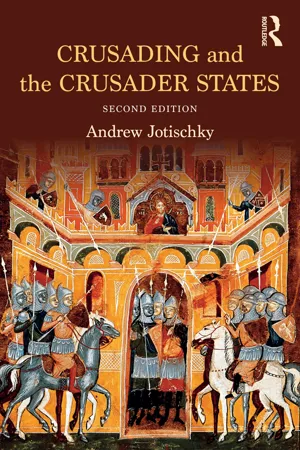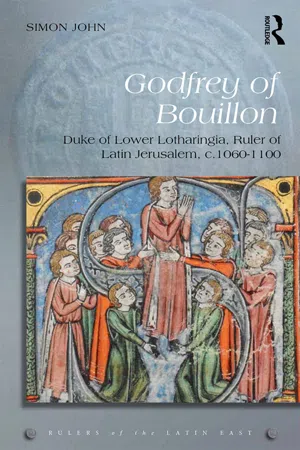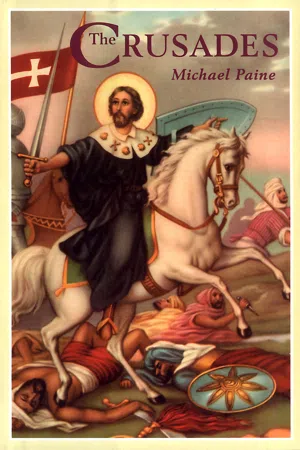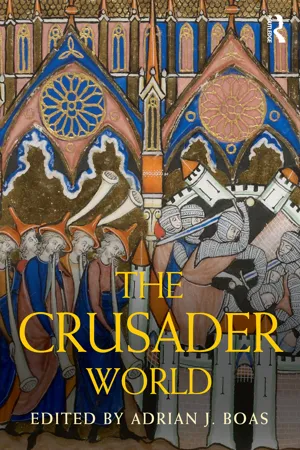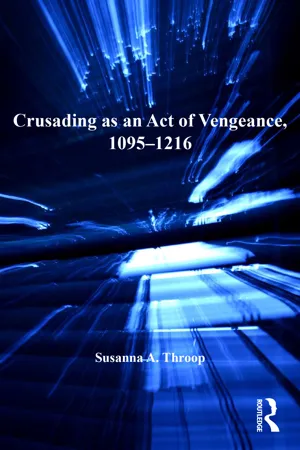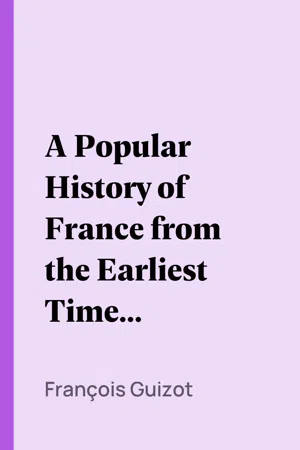History
Pope Urban II
Pope Urban II was the head of the Catholic Church from 1088 to 1099. He is best known for initiating the First Crusade in 1095, calling for Christians to reclaim the Holy Land from Muslim rule. His speech at the Council of Clermont rallied support for the Crusades, shaping the course of European history and the relationship between Christianity and Islam.
Written by Perlego with AI-assistance
Related key terms
7 Key excerpts on "Pope Urban II"
- eBook - ePub
- Andrew Jotischky(Author)
- 2017(Publication Date)
- Routledge(Publisher)
2 The papacy, the knighthood and the eastern MediterraneanKey Dates 1042 Neuvy Saint-Sépulcre (Berry) founded in imitation of Holy Sepulchre in Jerusalem 1053 Normans in Italy defeat papal army of Leo IX 1054 mutual excommunication of patriarch of Constantinople and papal legate 1057 Bishop Lietbert of Cambrai’s pilgrimage to Jerusalem cut short by Seljuq threat 1064 siege of Barbastro (Catalonia) 1066 Norman conquest of England 1073 Gregory VII becomes pope 1076 Seljuq victory over Byzantines at Manzikert 1080 Emperor-elect Henry IV invades Italy 1081 Alexios Komnenos becomes emperor in Constantinople 1080s emergence of Fideles Sancti Petri 1084 Gregory VII calls on faithful to defend Church with arms 1089 Urban II becomes pope 1092 death of Seljuq sultan Malikshah and Fatimid khalif Al-Mustansir The origins of Urban’s call to arms in 1095, and of what was to become in the twelfth and thirteenth centuries part of political and religious life throughout Europe, can be found in the previous half-century in a series of events and developments in both the West and the East. This chapter will examine the impact of reforming ideals in the papacy in the eleventh century; the religious convictions of the western knighthood; and the political fragmentation of the Islamic and Byzantine worlds before the First Crusade.The papacy on the eve of the First Crusade
Modern historians have tended to follow most of their medieval predecessors in seeing the Council of Clermont, in November 1095, as the starting point of the Crusades. If we are looking for a single moment at which crusading can be said to have started, then the final day of the council, on which Urban II publicly proclaimed the expedition to the east to an audience comprised of senior clerics and some of the nobility of the Auvergne, certainly has more claim than any other. But we cannot hope to understand Urban’s dramatic words at Clermont, still less the events of the First Crusade, without first considering the context in which the pope delivered his rousing message of holy war. If we are to trace his own thinking on the subject of sacralised violence, we need first to examine how the nature of the papal office that he held and its ideological direction had changed during the eleventh century. We must also consider the nature of the audience, and ask why his preaching struck such a responsive note in western European society. Finally, we need to look beyond Clermont, indeed beyond Rome and the West, to explore the geographical context of the First Crusade. The crusade was conceived and born in the West, but it was only successful because of a coincidence of political factors in the Islamic and Byzantine worlds, and its impact was felt throughout the eastern Mediterranean. - eBook - ePub
Godfrey of Bouillon
Duke of Lower Lotharingia, Ruler of Latin Jerusalem, c.1060-1100
- Simon John(Author)
- 2017(Publication Date)
- Routledge(Publisher)
3 The coming of the First Crusade, 1095–1096Pope Urban II’s call for the First Crusade
The origins of the First Crusade have been much discussed in modern scholarship. It is therefore necessary only to sketch a few details here. In March 1095, at the council of Piacenza, an embassy from the Byzantine Emperor Alexios Komnenos (1081–1118) reached Pope Urban II and reported on the situation in the Near East.1 These messengers informed those present at Piacenza that the powers of Asia Minor, Palestine, and Egypt were divided and weakened. They beseeched the pope to send military assistance there to help recover some of the Byzantine territory which had been lost in the late eleventh century.2 The Byzantine assessment of the Near East was accurate. In the mid-1090s, the Shi’ites of Fatimid Egypt were firmly divided from the predominantly Sunni powers of Palestine, which in theory was part of the Abbasid Caliphate centred upon Baghdad. Moreover, the political map of Palestine itself was extremely fragmented. Asia Minor had slipped out of Baghdad’s ambit into the hands of local rulers.3The Byzantine appeal seems to have prompted Urban to instigate a plan he had already been formulating. In August 1095, he crossed the Alps and embarked on a year-long tour of southern and central France (as a result of a dispute with King Philip I of France (1059–1108), he only travelled as far north as Le Mans). He was the first reigning pope to visit France for half a century. During his time there, he visited a number of towns, consecrated churches, and held several reforming councils. He also passed legislation aimed at extending the Peace of God to the areas he visited.4 On the penultimate day of the council he held at Clermont (18–28 November 1095), Urban called for an armed expedition to go to the East to free the Holy Sepulchre in Jerusalem and the other holy places from Muslim hands, and bring aid to the Christians who lived there. The pope apparently framed the enterprise as a pilgrimage to the Holy City, and instructed participants to distinguish themselves by adopting the sign of the cross. He told participants to depart on the feast of the Assumption (15 August) 1096, so that their journey east would coincide with the gathering of the harvest at the end of summer.5 - eBook - ePub
- Mike Paine(Author)
- 2012(Publication Date)
- Pocket Essentials(Publisher)
In 1095 however, a reclaimed Spain was centuries away. At the great council at Piacenza, Pope Urban II, amongst his other duties, received ambassadors from the Emperor Alexius. What messages they delivered are unknown. Alexius was making some headway in his fight against the Muslims and it is probable that he used a combination of his successes and the cost to the West should he fail as a lever to try and extract help from the Pope. The model was there in Spain, haphazard as it was, for uniting Christian forces against unbelievers. To Urban II, many personal reasons must have sprung to mind. What greater achievement could mark his papacy than a colossal campaign to free the sacred sites of the Holy Land? What effect might western involvement have on the possibilities of rapprochement with that 'dissident' eastern half of the Church? Regardless of the details, the idea for the Crusade - the taking up arms against Christ’s opponents, the great unifying cause in a Christendom split by petty disagreements and squabbles - took root in his mind between Piacenza and the first official announcement, in Clermont in France. Clermont was to be a council concerned with other clerical matters. Alongside the launch of the crusades, the Truce of God – a policy seeking to promote peace between Christian leaders in Europe – was strongly advocated. But it was to be remembered as the start of the Crusades.THE FIRST CRUSADE
On Tuesday, 27 November 1095, before a rapt and huge crowd outside the city of Clermont, Pope Urban II announced the call to arms. His speech, legend has it, was interrupted by shouts of 'Deus lo volt!' (God wills it!). Spontaneously (or so it appeared) both rich and poor present offered to go in an enormous outpouring of emotion. Despite the popular reception of his plan, there was a problem – Urban had not signed up any leading members of the nobility to his cause. He had an experienced and capable cleric, the Bishop of Le Puy, to take charge on behalf of the church, but who were the men who would organise and lead the armies?Yet this issue was quickly resolved. Beside the noble intent to fight for Christ, the spiritual pull of the call to arms, a more prosaic, more secular reason encouraged young nobles to go should the thought of rewards in the hereafter prove insufficient: primogeniture. On the death of a male member of the nobility his property and wealth would, in most of Europe, pass to the eldest son. This meant that after exhausting that pool of fighting men who were motivated by faith, or by the desire for battle and for glory, there were many ambitious young men who saw the opportunity of making their fortune under the excuse of doing good. Living in an age without newspapers, without television, their prime source of information about the Holy Land was the Bible. The Land of Milk and Honey - eBook - ePub
- Adrian Boas, Adrian Boas(Authors)
- 2015(Publication Date)
- Routledge(Publisher)
Gabriele, 2012 , 812–13, who argues that “Gregory VII and Urban II belonged to similar, yet distinct, textual communities” and held differing views on Christian reconquest and restoration.- Others disagree ; cf. Ashe, 1999 , who fragments medieval religious experience and medieval crusading experience by suggesting that the Church expounded one model of crusading, reflecting papal resolve to assert control over secular rulers, while the Song of Roland expounded “a subversive antimodel of reality,” reflecting “its own, distinctive, form of secularized Christianity … opposed not only to Church theology, but to Church power.”
- Urban II to the counts Bernat of Besalú , Hugo of Ampurias, Guislabert of Roussilon, and Guillem of Cerdanya and their knights, c. July 1096, in Kehr, 1926 , 287–88 (no. 23); trans. based on O’Callaghan, 2003 , 33, with additions and amendments made by the author.
- Ibid. See also Erdmann, 1935 , 294–95/1977, 317; Riley-Smith and Riley-Smith, 1981 , 40; Goñi Gaztambide, 1958 , 60–61; Becker, 1964 –2012, 2:347–48; Housley, 1992 , 32–33; McCrank, 1974 , 264, 284–85 n51; Chevedden, 2005 b, 299–302. Pope Urban’s coordinated strategy of engaging the enemy on two fronts simultaneously finds a parallel in the Islamic world. When Aḥmad ibn Ḥanbal (d. 241/855) was asked about a man who wished to journey to Tarsus to fight the Byzantines while his own region of Islamic Central Asia was contending with the Turks, Ibn Ḥanbal responded by quoting the Qurʾānic Sūrat al-tawbah, āyah 123: “‘O believers, fight the unbelievers around you.’ It is not for anyone that he go from his own land while the enemy is in it, and fight someone other than them. Let him fight in defense of his lands, and drive away the enemies of God” (quoted in Sizgorich, 2009
- eBook - ePub
The Causes of War
Volume II: 1000 CE to 1400 CE
- Alexander Gillespie(Author)
- 2016(Publication Date)
- Hart Publishing(Publisher)
This call for military force, under the direction of the papacy, was a clear sign that the pope believed this war to be holy. In this connection, Urban II drew out two clear themes around which Christian Europe could direct their energies against a common enemy. First, Jerusalem was an occupied city of special symbolic significance that belonged to Christendom. Accordingly, he called upon Christian soldiers to:[C]apture the land the heathen have seized, the land God gave to the children of Israel, the land the Bible describes as all milk and honey … [Jerusalem] … this royal city, centre of the world, is now held captive by enemies ignorant of God and is made to serve their heathen ceremonies. It looks and longs for freedom.87Secondly, the Muslim occupation of Jerusalem was brutal, involving the enslavement of Christians, the rape of women, the destruction of Christian places of worship and the suppression of their faith. Specifically:[T]he barbarians … have seized the Holy City of Christ … we are stimulating the minds of knights to go on this expedition, since they might be able to restrain the savagery of the Saracens by their arms and restore the Christians to freedom.88This plea for help provoked a response that the Byzantine emperor probably did not expect as in the past, when Constantinople had asked for assistance from western Europe, it came in the shape of mercenaries; now an avalanche of foreign soldiers needed to cross Byzantine lands, for, as described in the Alexiad, ‘the whole of the West and all the barbarian tribes which swell … had all migrated in a single body and were marching into Asia’.89 The first swell moving towards Jerusalem was led by Peter the Hermit, a charismatic preacher who took up Pope Urban II’s call for a crusade. He directed a disorganised army of knights and peasants in 1096 (the ‘People’s Crusade), through Hungary towards the Holy Land, ahead of the First Crusade. Tens of thousands of people, including many women and children, joined the call. Emperor Alexius, dismayed by the influx of such a large and ill-disciplined force, arranged for the masses to be ferried across the Bosphorus. The People’s Crusade that arrived at Nicomedia (Izmir in modern-day Turkey), quarrelled amongst themselves and were fallen upon by a Seljuk force that destroyed them.90 - eBook - ePub
- Susanna A. Throop(Author)
- 2016(Publication Date)
- Routledge(Publisher)
Chapter TwoEarly Years: Crusading as Vengeance, 1095–1137In 1095 Pope Urban II did something rather unusual.1 He embarked on a papal preaching tour through France, making his way with due pomp and circumstance through villages and rural regions, where it is likely most people had never dreamed of seeing a real pope in the flesh. On the way he delivered a singular message, known to historians now as the sermon he gave at the Council of Clermont: Christians should embark on an armed pilgrimage to Jerusalem, to liberate the city and eastern Christians in general from the abusive tyranny of the Muslims. Because of the necessary hardships involved, this armed pilgrimage would serve as an act of penance, earning for participants remission of their sins.The resultant expedition that launched in two waves in 1096 is generally referred to now as the First Crusade. The second wave of the crusade was unexpectedly successful, conquering major cities like Nicaea and Antioch in 1097 and 1098, and taking Jerusalem itself in 1099. This success, viewed as nothing short of miraculous by contemporaries, encouraged a number of less successful expeditions eastward in 1100, 1101, and 1102. It also resulted in the production of an extraordinary number of written commemorations of the 1096 expedition.This chapter examines the idea of crusading as an act of vengeance in the crucial period surrounding the First Crusade, from 1095 through 1137, assessing the assertion made by Jonathan Riley-Smith and others that the idea of crusading as vengeance was predominant among the laity and faded after the taking of Jerusalem in 1099. The uniqueness, and significance, of this period has led me to adopt a slightly different approach for this chapter. While in the other chapters the sources for a given period are discussed together, for the period 1095–1137 they are discussed in terms of the participation of the authors in the First Crusade—eyewitness accounts and non-participant accounts. The eyewitness accounts were for the most part not written earlier than the non-participant accounts, but they were written by people who (as far as we can tell) witnessed the events that they describe. These authors were not only reporting the opinions or ideas of others, at least potentially they were reporting their own ideas and actions as part of a larger group. Their distinctiveness, and my treatment of the sources for the period, is supported by the evidence they provide.2 - François Guizot(Author)
- 2004(Publication Date)
- Perlego(Publisher)
In the open air he wore a woollen tunic, and over it a serge cloak which came down to his heels; he had his arms and feet bare; he ate little or no bread, and lived chiefly on wine and fish.” In 1095, after the preaching errantry of Peter the Hermit, Pope Urban II. was at Clermont, in Auvergne, presiding at the grand council, at which thirteen archbishops and two hundred and five bishops or abbots were met together, with so many princes and lay-lords, that “about the middle of the month of November the towns and the villages of the neighborhood were full of people, and divers were constrained to have their tents and pavilions set up amidst the fields and meadows, notwithstanding that the season and the country were cold to an extreme.” The first nine sessions of the council were devoted to the affairs of the Church in the West; but at the tenth Jerusalem and the Christians of the East became the subject of deliberation. The Pope went out of the church wherein the Council was assembled and mounted a platform erected upon a vast open space in the midst of the throng. Peter the Hermit, standing at his side, spoke first, and told the story of his sojourn at Jerusalem, all he had seen of the miseries and humiliations of the Christians, and all he himself had suffered there, for he had been made to pay tribute for admission into the Holy City, and for gazing upon the spectacle of the exactions, insults, and tortures he was recounting. After him Pope Urban II. spoke, in the French tongue, no doubt, as Peter had spoken, for he was himself a Frenchman, as the majority of those present were, grandees and populace. He made a long speech, entertaining upon the most painful details connected with the sufferings of the Christians of Jerusalem, “that royal city which the Redeemer of the human race had made illustrious by His coming, had honored by His residence, had hallowed by His passion, had purchased by His death, had distinguished by His burial
Index pages curate the most relevant extracts from our library of academic textbooks. They’ve been created using an in-house natural language model (NLM), each adding context and meaning to key research topics.
